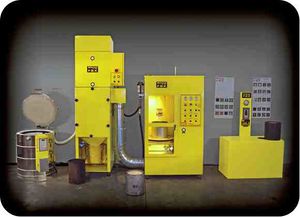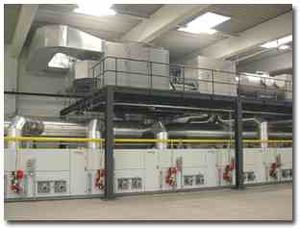Difference between revisions of "Thermal Cleaning Systems"
(Created page with "Category:Cleaning{{Knoppen}} <noinclude><!------------------------------------------------ * READ THIS FIRST * Only edit this page if you can improve the content. * Imprope...") |
|||
| Line 1: | Line 1: | ||
[[Category:Cleaning]]{{Knoppen}} | [[Category:Cleaning]]{{Knoppen}} | ||
[[File:Thermal_cleaning_systems_01.jpg|thumb|right|Thermal Cleaning System]] | |||
[[File:Thermal_cleaning_systems_02.jpg|thumb|right|Complete Cleaning System]] | |||
Cleaning Systems completely remove coatings from all types of hardware and parts - with no carbon residue. Absolute temperature control and thermal uniformity permits cleaning of complex critical hardware with minimal risk of distortion or metallurgical damage. The use of '''Thermal cleaning systems''' permits thorough cleaning of even fully assembled components. Many standard sized models (large, small, batch, or continuous) with a variety of options are available to meet your application(s). | |||
'''Thermal cleaning systems''' are a next generation of cleaning equipment designed to meet the needs of high production while remaining environmentally friendly. Thermal cleaning removes the need to use harsh chemicals with costly disposal costs. | |||
Each system is based on a modular basket design that allows the work piece and basket to be completely removed from each cell and placed into the next stage while saving time and protecting the operator. Standardized cells can be added to speed up processes or expand production. | |||
Each Thermal Cleaning system consists of a thermal oven, a shot blast cabinet (with dust collector), and a shaker/tumbler cooling unit. Each oven features a main burner that will bake and carbonize and grease, oil, debris or dirt on the work piece. A second stage afterburner in the exhaust eliminates any potentially hazardous fumes. After baking, the parts are transferred (via a material handling fixture) to the part is blasted while rotating to clean and prepare the surface for painting or reassembly. After blasting, the parts are again transferred to the shaker/tumbler cool down cabinet where the parts are rotated to remove shot or debris and a cooling fan removes any residual heat from the process. | |||
==Video== | |||
<youtube>aU5MBmoU-WE</youtube> | |||
Latest revision as of 11:55, 22 June 2013
Cleaning Systems completely remove coatings from all types of hardware and parts - with no carbon residue. Absolute temperature control and thermal uniformity permits cleaning of complex critical hardware with minimal risk of distortion or metallurgical damage. The use of Thermal cleaning systems permits thorough cleaning of even fully assembled components. Many standard sized models (large, small, batch, or continuous) with a variety of options are available to meet your application(s).
Thermal cleaning systems are a next generation of cleaning equipment designed to meet the needs of high production while remaining environmentally friendly. Thermal cleaning removes the need to use harsh chemicals with costly disposal costs.
Each system is based on a modular basket design that allows the work piece and basket to be completely removed from each cell and placed into the next stage while saving time and protecting the operator. Standardized cells can be added to speed up processes or expand production.
Each Thermal Cleaning system consists of a thermal oven, a shot blast cabinet (with dust collector), and a shaker/tumbler cooling unit. Each oven features a main burner that will bake and carbonize and grease, oil, debris or dirt on the work piece. A second stage afterburner in the exhaust eliminates any potentially hazardous fumes. After baking, the parts are transferred (via a material handling fixture) to the part is blasted while rotating to clean and prepare the surface for painting or reassembly. After blasting, the parts are again transferred to the shaker/tumbler cool down cabinet where the parts are rotated to remove shot or debris and a cooling fan removes any residual heat from the process.
Video

